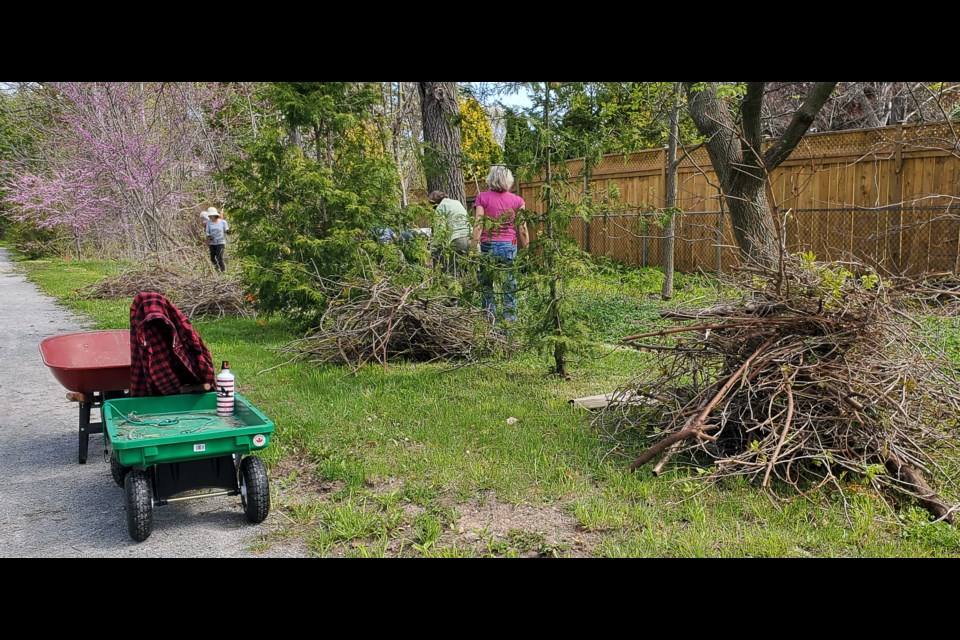Great news—work has begun for the preparation of the pollinator gardens on the Upper Canada Heritage Trail in Niagara-on-the-Lake that will be installed this month.
A group of volunteer weed-warriors came out on Thursday to begin removing brush, vines and invasive plants to make way for the installation of pollinator plants along the first section of the Heritage Trail, which is in the One Mile Creek Watershed. You will notice a lot of little flags along the path that are needed to get this work done, so please do not move or remove any of these flags.
The volunteer group called Protect Our Pollinators have put an enormous amount of time and effort into making this project happen. Our volunteer group came together in November 2022 to promote pollinator awareness in the community. We rely on these species to pollinate the majority of our flowers and food crops so they are key to the survival of the humans. Because there is a mass decline in bee, moth, bat, and butterfly populations, we wanted to do something to help these creatures.
Since the inception of this group, we have managed to produce 10 articles under the title The Buzz on Pollinators, informing locals about the key aspects of creating pollinator habitats. The town has approved our group to install pollinator plants along the Heritage Trail with the generous donation from the Goettler Family Foundation. Because of their contribution, you will soon see many new pollinator plants growing along the trail.
This year’s installations will take place along the first section of the Heritage Trail, starting at John Street and ending at Paffard. The entrance to the trail will have a keystone tree dedicated to the Goettler family and two Eastern Redbud trees to welcome you. Just past the fence, we plan to create an instructional pollinator garden where you can learn to create one of your own. Along the path you will see several groves of native shrubs and wild flowers as well as a large installation of pollinator friendly trees. These pollinator patches are intended to create an entire ecosystem to serve native species with everything they need to complete their life cycle.
Our group engaged the consulting services of Niagara Beeway to guide us through the bed preparation, plant selection, and species integration for long-term habitat restoration. Niagara Beeway has over 30 years’ experience in habitat restoration for bees, pollinators and other endangered species such as birds, turtles, raptors, and native plants. Our goal is to attract species such as native bees, Swallowtail butterflies, Monarchs, Hummingbirds and many other interdependent creatures looking for food and habitat.
The work has just begun with the clearing of underbrush, weeds and vines, it’s only the first step and will be an ongoing struggle. There are many invasive plants overtaking the trail either naturally or have been planted by well-meaning people not aware of the damage these plants are causing.
We hope to educate everyone about the harm of planting invasive species such as English ivy, gout weed, Japanese barberry, and lily of the Vblley, forget-me-not and lesser celandine. It is almost impossible to get rid of these plants once they have taken hold.
he use of pesticide is not a viable option. That’s why we are trying an environmentally-friendly technique called smothering to kill these plants. Instead of spraying them, bales of straw will be rolled out over the area where we intend to create pollinator patches. These bales will be left in the rain and the sun until the plants underneath have been suffocated. This matted straw may look unpleasant but please be patient with the unsightliness, as it is a work in progress!
Once the straw begins to pack down and create a mat, some of the larger shrubs such as spicebush, staghorn sumac, eastern red bud and service berry bushes will be planted. The success of the beds will be monitored, and hopefully by mid-June we will be able to add the more delicate flowering plants.
Our vision is to see the path filled with flowers and butterflies, but native pollinator plants take time to get established. It will be a long-term process and may take a several years before our vision is complete. In the meantime, we will keep you regularly updated about the progress. Please keep an eye open on your walks along the trail as our project evolves.
If you would like to volunteer to help with our upcoming projects, please contact Klara at [email protected].
Tip of the week: Be patient with us, great things take time to manifest.



